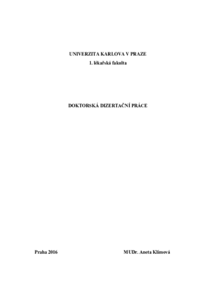Mechanismy patogeneze experimentální autoimunitní uveitidy a možnosti jejich ovlivnění.
The Mechanism of Pathogenesis of Experimental Autoimmune Uveitis and Possilbilities of Their Regulation
dizertační práce (OBHÁJENO)

Zobrazit/
Trvalý odkaz
http://hdl.handle.net/20.500.11956/2069Identifikátory
SIS: 154117
Kolekce
- Kvalifikační práce [4552]
Autor
Vedoucí práce
Konzultant práce
Svozílková, Petra
Oponent práce
Pitrová, Šárka
Holáň, Vladimír
Fakulta / součást
1. lékařská fakulta
Obor
-
Katedra / ústav / klinika
Oční klinika 1. LF UK a VFN
Datum obhajoby
15. 9. 2016
Nakladatel
Univerzita Karlova, 1. lékařská fakultaJazyk
Čeština
Známka
Prospěl/a
Klíčová slova (česky)
experimentální autoimunitní uveitida, autoimunitní onemocnění, C57BL, 6, imunologické privilegium, mikrobiom, CD3+, F4, 80+, hematoretinální bariéra, autotolerance, bezmikrobní, gnotobiotický, mykofenolát mofetilKlíčová slova (anglicky)
experimental autoimmune uveitis, autoimmune disease, C57BL, 6, immune privilege, microbiome, CD3+, F4, 80+, hematoretinal barrier, self-tolerance, germ-free, gnotobiotic, mycophenolate mofetilÚvod: Autoimunitní uveitida postihuje zejména střední věkovou kategorii a přes stále se rozvíjející terapeutické možnosti způsobuje těžké postižení zraku. Vzhledem k široké klinické variabilitě je studium autoimunitní uveitidy v humánní medicíně limitované, proto byly vyvinuty experimentální modely. Cílem naší práce bylo zavést reprodukovatelný model experimentální autoimunitní uveitidy v České republice a dále na tomto modelu sledovat zastoupení CD3+ a F4/80+ buněk v sítnici, zhodnotit vliv mikrobiálního prostředí na intenzitu nitroočního zánětu a testovat terapeutické možnosti. Materiál a metody: Myším kmene C57BL/6J byl aplikován sítnicový antigen (IRBP 1-20, interphotoreceptor retinoid binding protein) potencovaný kompletním Freundovým adjuvans a pertusovým toxinem, který vyvolá mírnou zadní autoimunitní uveitidu. Myši pocházely z konvenčního a gnotobiotického (bezmikrobního) chovu. Intenzita uveitidy byla hodnocena podle standardizovaných protokolů in vivo biomikroskopicky a post mortem histologicky na řezech barvených hematoxylin eozinem. Vzorky tkání byly analyzovány také imunohistochemicky a průtokovou cytometrií. Standardní sledovací doba experimentu byla 35 dnů. Myši s uveitidou z konvenčního chovu byly léčeny perorálními antibiotiky (metronidazol a ciprofloxacin) podávanými profylakticky...
Introduction:Uveitis in an ocular inflammation affecting mostly people of working age. Uveitis is responsible for severe visual impairment despite of expanding new therapeutics. The animal models of uveitis were established, because the wide clinical variability of uveitis limits the studies in human medicine. The goal our project was to establish a reproducible model of experimental autoimmune uveitis in Czech Republic, and further on this model to observe the frequency of CD3+ and F4/80+ cells in retina, to assess the influence of microbial environment on intensity of intraocular inflammation and to test the therapeutical possibilities. Material and methods: The C57BL/6J mice were immunized by retinal antigen (IRBP 1-20, interphotoreceptor retinoid binding protein), enhanced by complete Freund's adjuvant and pertussis toxin and mild posterior autoimmune uveitis was induced. The mice were bred in conventional and germ-free (gnotobiotic) conditions. The uveitis intensity was evaluated in vivo biomicroscopically and post mortem histologically on hematoxylin eosin stained sections according to the standard protocol. The histological eye specimen were analyzed also by imunohistochemisty and by flow cytometry. Each experiment was performed for 35 days. The conventional mice with uveitis were treated...
